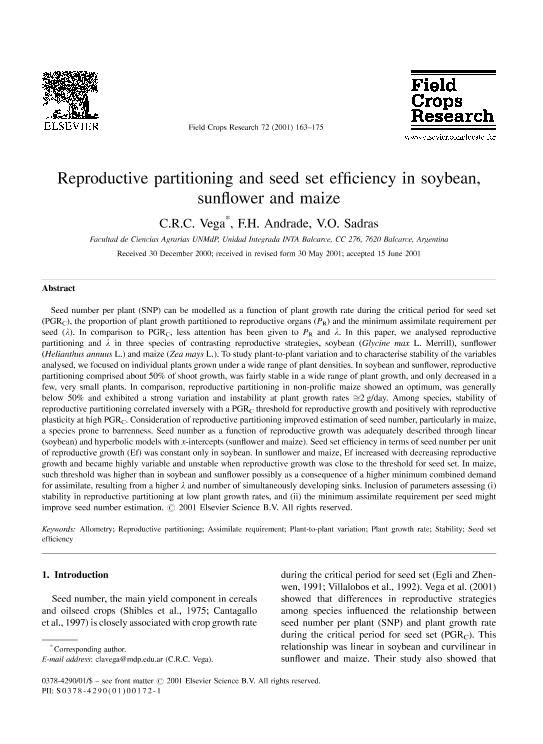Artículo
Reproductive partitioning and seed set efficiency in soybean, sunflower and maize
Fecha de publicación:
09/2001
Editorial:
Elsevier Science
Revista:
Field Crops Research
ISSN:
0378-4290
Idioma:
Inglés
Tipo de recurso:
Artículo publicado
Clasificación temática:
Resumen
Seed number per plant (SNP) can be modelled as a function of plant growth rate during the critical period for seed set (PGRC), the proportion of plant growth partitioned to reproductive organs (PR) and the minimum assimilate requirement per seed (λ). In comparison to PGRC, less attention has been given to PR and λ. In this paper, we analysed reproductive partitioning and λ in three species of contrasting reproductive strategies, soybean (Glycine max L. Merrill), sunflower (Helianthus annuus L.) and maize (Zea mays L.). To study plant-to-plant variation and to characterise stability of the variables analysed, we focused on individual plants grown under a wide range of plant densities. In soybean and sunflower, reproductive partitioning comprised about 50% of shoot growth, was fairly stable in a wide range of plant growth, and only decreased in a few, very small plants. In comparison, reproductive partitioning in non-prolific maize showed an optimum, was generally below 50% and exhibited a strong variation and instability at plant growth rates ≅2 g/day. Among species, stability of reproductive partitioning correlated inversely with a PGRC threshold for reproductive growth and positively with reproductive plasticity at high PGRC. Consideration of reproductive partitioning improved estimation of seed number, particularly in maize, a species prone to barrenness. Seed number as a function of reproductive growth was adequately described through linear (soybean) and hyperbolic models with x-intercepts (sunflower and maize). Seed set efficiency in terms of seed number per unit of reproductive growth (Ef) was constant only in soybean. In sunflower and maize, Ef increased with decreasing reproductive growth and became highly variable and unstable when reproductive growth was close to the threshold for seed set. In maize, such threshold was higher than in soybean and sunflower possibly as a consequence of a higher minimum combined demand for assimilate, resulting from a higher λ and number of simultaneously developing sinks. Inclusion of parameters assessing (i) stability in reproductive partitioning at low plant growth rates, and (ii) the minimum assimilate requirement per seed might improve seed number estimation.
Archivos asociados
Licencia
Identificadores
Colecciones
Articulos(OCA PQUE. CENTENARIO)
Articulos de OFICINA DE COORDINACION ADMINISTRATIVA PQUE. CENTENARIO
Articulos de OFICINA DE COORDINACION ADMINISTRATIVA PQUE. CENTENARIO
Citación
Vega, Claudia Rosa Cecilia; Andrade, Fernando Héctor; Sadras, Victor Oscar; Reproductive partitioning and seed set efficiency in soybean, sunflower and maize; Elsevier Science; Field Crops Research; 72; 3; 9-2001; 163-175
Compartir
Altmétricas




